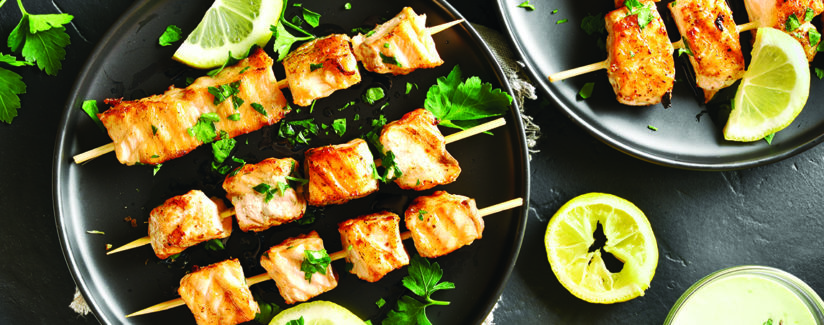
How Are Farmed Fish Raised?
08/14/2019
Have you ever wondered about the ins and outs of aquaculture? Where do the fish live? What do they eat? What do all the labels on the packages truly mean?
In order to give us the ‘low-down’ on fish farming, we asked expert Dr. Stefanie Colombo from Dalhousie University in Nova Scotia, Canada. Dr. Colombo is passionate about marine life and an expert on aquaculture.
What is the difference between wild and farmed fish?
Dr. Colombo: “Wild fish grow naturally in ponds, lakes, rivers, and oceans, and are then caught for human consumption. Farmed fish are grown entirely in ‘captivity’ from egg to harvest. Another form of farming is called ‘ranching’ where young fish are caught and then raised in cages until it is time to harvest. For example, tuna is often ranched rather than farmed, whereas salmon are farmed.”
How are farmed fish contained? In nets or ponds or tanks?
Dr. Colombo: “Farmed fish are contained using different methods, sometimes depending on the species and their natural habitat, either freshwater or marine. In Canada, we grow fish in nets pens, ponds and tanks. Sometimes a combination of methods are used. For example, Atlantic salmon are raised in tanks for the first part of their life, until they are about 100 grams in size, then they are transported to net pens in seawater, in coastal areas in Atlantic Canada and British Columbia. This method is used because this resembles the natural life cycle of salmon, where the first part of their life is spent in freshwater and then grown to maturity in seawater. Salmon can also be grown completely land-based in tanks without the net pens in seawater. In Canada, we also grow some species in ponds, like striped bass, but in other parts of the world (Asia, Africa) pond culture is the most popular way to grow certain species, like tilapia and shrimp.”
Are organic fish wild or farm raised?
Dr. Colombo: “Organic fish are farm-raised organic. That might be counter-intuitive to some people, because what could be more organic than a fish that came right from the sea? But part of the organic certification ensures the methods and practices of how the animal was raised (or the plant was grown) are of organic standards, which is impossible to ensure when catching fish in the wild. Canada’s organic aquaculture standard prohibits the use of antibiotics, herbicides and genetically modified organisms. About 3% of Canadian seafood producers have chosen to pursue organic certification. These include producers of Atlantic salmon, Pacific chinook salmon, sturgeon and caviar, sablefish, trout, mussels, and seaweed.
“Organic farm-raised shouldn’t be confused with sustainability certification that you often see on wild fish packaging (e.g., Ocean Wise ®, Marine Stewardship Council -MSC Certified). Sustainable seafood helps to relieve the pressure on overfished species while leaving enough fish in the ocean, respecting habitats and ensuring people who depend on fishing can maintain their livelihoods. These labels ensure that the seafood is sustainable (wild or farmed), but they are not necessarily organic. Some farmed seafood can be both sustainably and organic-certified.”
What is the nutrition profile difference between organic, wild and farmed?
Dr. Colombo: “The nutritional profile of wild vs. farmed vs. organic farmed is not very different when you compare fish of the same species. The most important factor to consider is the composition of the diet and where they are grown (commercial feeds in culture vs. natural prey in the wild), which has an influence on the nutritional content of the fillets. In general, because of this variability, there is not a sound scientific conclusion, because it can depend on where the fish was caught, or the farm it was harvested from.”
Learn more about the food that farmed fish eat.
How can we ensure that the organic-labelled fish we buy are truly organic?
Dr. Colombo: “Organic standards in Canada are set by the Canadian Food Inspection Agency (CFIA). Farmers must adhere to these standards, but also need to create and maintain a detailed organic management plan, which describes all practices, record keeping, etc. Organic seafood producers are also audited by the CFIA-accredited organic certifier. This ensures that the organic labelled seafood is regulated, monitored, and traceable.”
Farmed fish are raised in different types of systems, sometimes depending on the species and their natural habitat, either freshwater or marine. Certified organic fish are always farm-raised. The nutrition profile is similar between wild, farmed and organic fish in the same species.


























